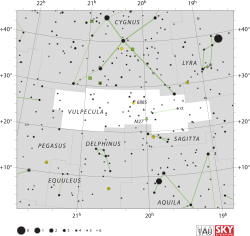Star in the constellation Vulpecula
27 Vulpeculae is a single, blue-white star in the northern constellation of Vulpecula . It is a dim star, visible to the naked eye, with an apparent visual magnitude of 5.59. An annual parallax shift of 10.6692±0.0483 mas provides a distance estimate of about 306 light-years . It is moving closer with a heliocentric radial velocity of −22 km/s, and will make perihelion passage at a distance of around 119 ly (36.56 pc) in 3.75 million years.
This is a B-type main-sequence star with a stellar classification of B9 V. It is spinning rapidly, showing a projected rotational velocity of 335. The star has an estimated 2.77 times the mass of the Sun and about 3.1 times the Sun's radius . It is radiating 75 times the Sun's luminosity from its photosphere at an effective temperature of 10,789 K.
References
^ Brown, A. G. A. ; et al. (Gaia collaboration) (2021). "Gaia Early Data Release 3: Summary of the contents and survey properties" . Astronomy & Astrophysics 649 : A1. arXiv :2012.01533 . Bibcode :2021A&A...649A...1G . doi :10.1051/0004-6361/202039657 . S2CID 227254300 .doi :10.1051/0004-6361/202039657e ). Gaia EDR3 record for this source at VizieR .
^ Paunzen, E. (2015), "A new catalogue of Strömgren-Crawford uvbyβ photometry", Astronomy & Astrophysics , 580 : A23, arXiv :1506.04568 , Bibcode :2015A&A...580A..23P , doi :10.1051/0004-6361/201526413 , S2CID 73623700 .
^ Cowley, A.; et al. (April 1969), "A study of the bright A stars. I. A catalogue of spectral classifications", Astronomical Journal , 74 : 375–406, Bibcode :1969AJ.....74..375C , doi :10.1086/110819
^ Zorec, J.; Royer, F. (January 2012), "Rotational velocities of A-type stars. IV. Evolution of rotational velocities", Astronomy & Astrophysics , 537 : A120, arXiv :1201.2052 , Bibcode :2012A&A...537A.120Z , doi :10.1051/0004-6361/201117691 , S2CID 55586789 .
^ Anderson, E.; Francis, Ch. (2012), "XHIP: An extended hipparcos compilation", Astronomy Letters , 38 (5): 331, arXiv :1108.4971 , Bibcode :2012AstL...38..331A , doi :10.1134/S1063773712050015 , S2CID 119257644 .
^ Gontcharov, G. A. (2006), "Pulkovo Compilation of Radial Velocities for 35 495 Hipparcos stars in a common system", Astronomy Letters , 32 (11): 759–771, arXiv :1606.08053 , Bibcode :2006AstL...32..759G , doi :10.1134/S1063773706110065 , S2CID 119231169 .
^ Pasinetti Fracassini, L. E.; et al. (2001), "Catalogue of Apparent Diameters and Absolute Radii of Stars (CADARS)", Astronomy & Astrophysics , 367 (Third ed.): 521–24, arXiv :astro-ph/0012289 , Bibcode :2001A&A...367..521P , doi :10.1051/0004-6361:20000451 , S2CID 425754 .
Huang, W.; Gies, D. R. (August 2008), "Stellar Rotation in Field and Cluster B Stars", The Astrophysical Journal , 683 (2): 1045–1051, arXiv :0805.2133 , Bibcode :2008ApJ...683.1045H , doi :10.1086/590106 , S2CID 18926523 , 1045–1051.
"27 Vul" . SIMBAD Centre de données astronomiques de Strasbourg . Retrieved 2018-04-21.Eggleton, P. P.; Tokovinin, A. A. (September 2008), "A catalogue of multiplicity among bright stellar systems", Monthly Notices of the Royal Astronomical Society , 389 (2): 869–879, arXiv :0806.2878 , Bibcode :2008MNRAS.389..869E , doi :10.1111/j.1365-2966.2008.13596.x , S2CID 14878976 .
External links
Categories :
Text is available under the Creative Commons Attribution-ShareAlike License. Additional terms may apply.
**DISCLAIMER** We are not affiliated with Wikipedia, and Cloudflare.
The information presented on this site is for general informational purposes only and does not constitute medical advice.
You should always have a personal consultation with a healthcare professional before making changes to your diet, medication, or exercise routine.
AI helps with the correspondence in our chat.
We participate in an affiliate program. If you buy something through a link, we may earn a commission 💕
↑
